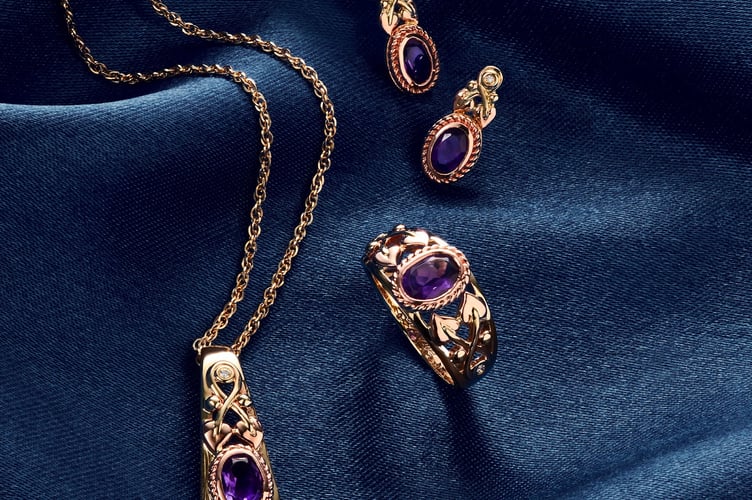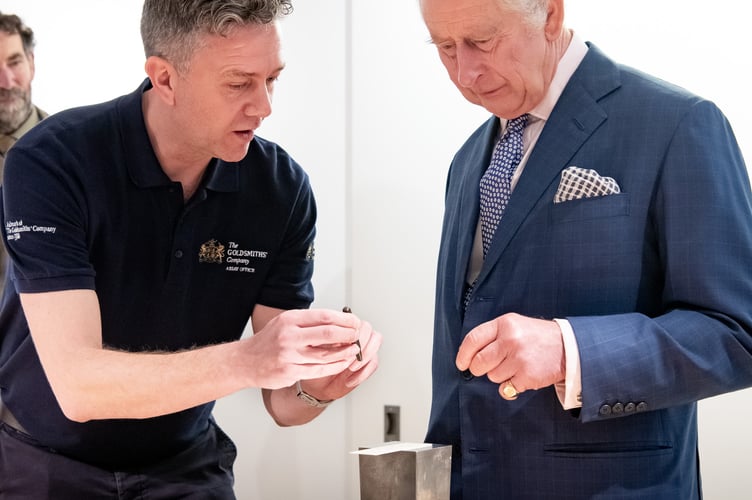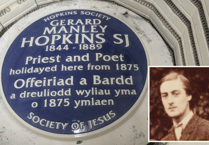Gwynedd’s association with King Charles and the Royal Family goes back a long way. The investiture of Prince Charles took place at Caernarfon Castle in 1969. Fittingly, the proclamation of Charles as King also took place there last September.
There have been many royal visits to Gwynedd over the years, and when the Queen was crowned, street parties took place throughout the county. So far this year, Gwynedd Council has received just one application for a street party in Barmouth, but other celebrations will be held, and there are plans to mark the Coronation in different ways.
Bangor councillor Steve Bell (Hirael ward) will attend a garden party at Buckingham Palace. The owner of high street shop All Sewn Up, said the day will be a mix of civic and family pride.
“Curiously enough, both my grandfather and grandmother were invited to attend similar Royal garden parties in their own right in recognition of their respective service to the RAF,” he said.
“To represent the city of Bangor at this extra prestigious event will be a very true honour to me and the city.”
Queen Victoria gifted the Corporation of Bangor Royal Charter in 1884 and when Prince of Wales, King Charles was Chancellor of Bangor University.
Fellow councillor Mark Roberts will be taking Bangor’s ceremonial civic mace to Royal jewellers Wartski of St James, London.
It comes after the family firm, which was founded in Bangor in 1865 and which has held royal warrants since the era of King Edward VII, heard of the mace’s dire state and offered to repair it.
“Two royal contacts with Bangor in a matter of a week must be quite unique,” said Cllr Roberts.
“I think Cllr Bell has the advantage; a Buckingham Palace royal garden party. The best I can hope for is a British Rail sandwich,” he quipped.
Clogau, which has a mine near Ganllwyd, Dolgellau, has released a new collection of jewellery to celebrate the coronation of King Charles III and his love of gardening.
For the first time in seven decades, on 6 May, King Charles III will ascend the 700-year-old throne on which King Henry VIII, Queen Victoria and Queen Elizabeth II sat, and Clogau’s Tree of Life Delphinium Collection is engraved with the coronation date and inspired by King Charles’ favourite purple flowers.
Clogau has also produced two other Coronation collections – Lilibet and Lily of the Valley. The Lilibet collection takes inspiration from Queen Elizabeth II’s coronation gown, and the Lily of the Valley collection is inspired by Queen Victoria.

Explaining their links to Royalty, Clogau’s website states: “An ingot of Welsh gold presented to Queen Victoria had been exhausted by the end of the 1960s and so, in 1986, a kilogram ingot of 99 per cent pure Gwynfynydd gold from Gwynedd was presented to Queen Elizabeth II to commemorate her 60th birthday.”
Recalling the history of their mine at Dolgellau, the website states: “Gwynfynydd was worked from a number of different levels, with access into the mountain by horizontal tunnels (adits). Miners laboured by candlelight. In the early days, shotholes were drilled by hand, using a hammer and steel drill, charged with explosives and blasted. By the end of the century, compressed air drills and other tools were becoming available. Ore extraction (stoping) was carried out both overhand and underhand. In overhand stopes, broken rock accumulated to provide a working platform. Underhand stopes were roofed with timber. The ore was hauled to the surface in wagons on narrow-gauge rails.”
According to Clogau, “gold was first discovered at Gwynfynydd in 1863, but no profitable amounts were found until 1887”.
Clogau has reproduced diary entries of Dolgellau man Hugh Pugh, who started working at Gwynfynydd in 1888.
At this time about 200 workers were employed, many of them boys under 15, and a 10-hour shift was usual. Pugh wrote that local shops were stocked with trays of gold quartz for sale to visitors: “There was a gold rush here, miners everywhere...” Many men lived in barracks at the mine, or lodged at nearby farms. Others walked long distances from home each day. Hugh walked eight-and-a-half miles to work.
He wrote: “We used to meet on the bridge at 3 o’clock with our Wallets, a big homemade loaf in one hand and rations in the other, and start work at 7 o’clock”.
Clogau’s website states: “A cart and horse went to Dolgellau each day for supplies and once a week, bread and groceries were delivered to Gwynfynydd. There was little entertainment for the resident miners, apart from ‘sing-songs’ on Friday nights and a concert once a month. One manager opened a reading room and started a Bible class. By 1900 the scale of wages was 3/6d (three shillings and sixpence) for a miner and assayer, 1/6d for a boy and 1/1d for a donkey.”
The website adds: “The rocks at Gwynfynydd Gold Mine are mostly of the Cambrian geological age, around 550 million years old. They are mainly composed of ancient sediments laid down in a large sea basin, which stretched from Shropshire to beyond Anglesey. Around 400 million years ago, there was a period of mountain building caused by intense volcanic activity throughout the whole of Snowdonia. Large layers of ash were laid down and the sediments were shattered, folded and faulted.”
The Cross of Wales, a new processional cross presented by His Majesty King Charles III as a centenary gift to the Church in Wales, will lead the Coronation procession at Westminster Abbey on 6 May.
In a significant ecumenical gesture, the Cross of Wales will incorporate a relic of the True Cross, the personal gift of Pope Francis to His Majesty The King to mark the Coronation. Inscribed with words from St David’s last sermon, the Cross of Wales was blessed by the Archbishop of Wales and Bishop of Bangor, Andrew John, at Holy Trinity Church, Llandudno, on 19 April.
The gift of the cross was commissioned by His Majesty The King, as Prince of Wales, to celebrate the centenary of the Church in Wales, with the Goldsmiths’ Company delivering the design and production processes. Designed and made by master silversmith Michael Lloyd, in consultation with the Royal Collection, it is crafted from recycled silver bullion, provided by the Royal Mint at Llantrisant, a shaft of Welsh windfall timber and a stand of Welsh slate.
Words from the last sermon of St David are on the back of the Cross in Welsh: “Byddwch lawen. Cadwch y ffydd. Gwnewch y Pethau Bychain”, which translates as: “Be joyful. Keep the faith. Do the little things.”

In compliance with the Hallmarking Act, the silver elements of the Cross bear a full hallmark (of the London Assay Office), including the Royal Mark (leopard’s head) which was applied by The King himself in November 2022 when visiting The Goldsmiths’ Centre in London.
The cross will be officially received by the Church in Wales at a service to follow the Coronation and its use going forward will be shared between the Anglican and Catholic Churches in Wales.
Welcoming the gift on behalf of the Church in Wales, Archbishop Andrew, who is also Bishop of Bangor, said: “We are honoured His Majesty has chosen to mark our centenary with a cross that is both beautiful and symbolic. Its design speaks to our Christian faith, our heritage, our resources and our commitment to sustainability. We are delighted too that its first use will be to guide Their Majesties into Westminster Abbey at the Coronation Service.”
Speaking on behalf of the Roman Catholic Church in Wales, the Archbishop of Cardiff and Bishop of Menevia, Mark O’Toole, said: “With a sense of deep joy we embrace this Cross, kindly given by King Charles, and containing a relic of the True Cross, generously gifted by the Holy See. It is not only a sign of the deep Christian roots of our nation but will, I am sure, encourage us all to model our lives on the love given by our Saviour, Jesus Christ. We look forward to honouring it, not only in the various celebrations that are planned, but also in the dignified setting in which it will find a permanent home.”
Dr Frances Parton, Deputy Curator of The Goldsmiths’ Company, who managed the commission said: “The Cross of Wales shows the relevance of traditional skills and craftsmanship in the modern world. Using the ancient craft of chasing silver, Michael Lloyd has created a beautiful object which combines a powerful message with a practical purpose. We are thrilled that the Cross will both feature in the Coronation and see regular use within the Church in Wales.”
Designer and maker Michael Lloyd said: “This project started with a love of the material, its malleability, its potential for expression. The commission has allowed me to delve into the previous 1,000 years of faith and history. Now, with more than 267,000 hammer blows, the cross has emerged from the inanimate sheets of silver, and I am delighted it will be used as part of the Coronation Service.”
“Inspired by medieval Welsh art and design, The Cross of Wales combines historical reference with the very best contemporary craftsmanship”, said Tim Knox, Director of the Royal Collection.
“It has been a unique and interesting project which we have been delighted to consult upon.”

Although smaller celebrations are due to take place, just one application has been made to hold a street party to celebrate the Coronation of King Charles III in Gwynedd.
A Gwynedd Council spokesperson said: “We can confirm that the council has currently received one application to hold a Coronation street party in the county, which is in Abermaw (Barmouth).”
King Charles III’s coronation will take place on Saturday, 6 May at Westminster Abbey, with an additional bank holiday being created on Monday, 8 May across the UK. In the run-up, communities were invited to apply to their local county council for road closures, free of charge, to allow them to hold communal street parties.
Welsh Conservative MS Sam Rowlands, Shadow Minister for Local Government and Tom Giffard MS, Shadow Minister for Culture, Tourism and Sport, have been encouraging councils to mark the occasion, and have written to every unitary local authority in Wales to push for councils to make the most of the opportunities of the coronation.
Mr Rowlands said: “Councils have the opportunity to bring together the community in celebration of the coronation of our King. Authorities should hold screenings alongside other activities, facilitating a bank holiday weekend to remember.
“Councils have a responsibility to promote the coronation and encourage community participation in it across Wales, such a momentous occasion is an excellent opportunity for councils to galvanise the community.”
Mr Giffard said: “Wales has always had strong ties with the monarchy. With our new King a Welsh speaker, this coronation is an important moment for Wales. Councils must make sure venues across Wales screen the live coronation ceremony and the coronation concert.
“The eyes of the world will be on Westminster Abbey on 6 May; let’s make sure all of Wales are.”
The BBC is suspending the licence fee for Coronation weekend, including for the Coronation concert, meaning councils have a unique opportunity to screen this historic occasion in public places via big screens.
Are you holding a street party or event to celebrate the Coronation of King Charles III? Why not send some photographs to us. Email [email protected]


.jpeg?width=209&height=140&crop=209:145,smart&quality=75)

